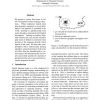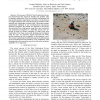354 search results - page 57 / 71 » Simplifying polygonal models using successive mappings |
ACL
2010
13 years 5 months ago
2010
We present a system that learns to follow navigational natural language directions. Where traditional models learn from linguistic annotation or word distributions, our approach i...
BMCBI
2004
13 years 7 months ago
2004
Background: Recent genomic and bioinformatic advances have motivated the development of numerous network models intending to describe graphs of biological, technological, and soci...
IROS
2007
IEEE
14 years 1 months ago
2007
IEEE
— The success of NASA’s Mars Exploration Rovers has demonstrated the important benefits that mobility adds to planetary exploration. Very soon, mission requirements will impos...
ACCV
2006
Springer
14 years 1 months ago
2006
Springer
Abstract. This paper addresses the problem of articulated motion tracking from image sequences. We describe a method that relies on an explicit parameterization of the extremal con...
ICRA
2009
IEEE
13 years 5 months ago
2009
IEEE
Abstract-- A main difficulty that arises in the context of probabilistic localization is the design of an appropriate observation model, i.e., determining the likelihood of a senso...


